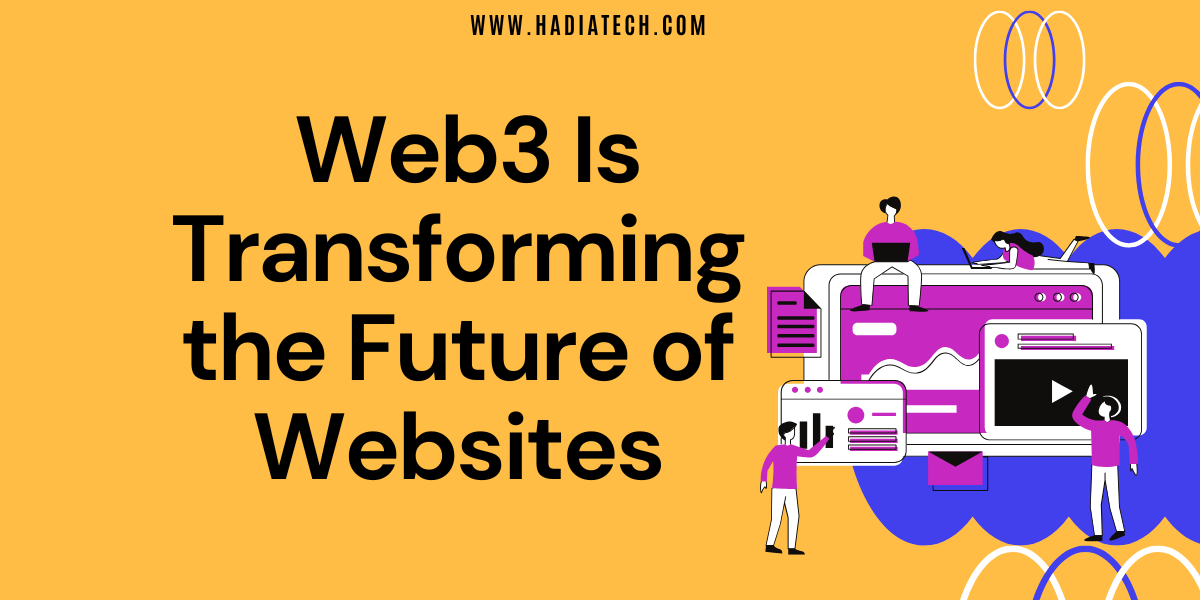How Web3 Is Transforming the Future of Websites
By 2025, the internet is going through a revolution in the guise of “Web3,” a decentralized concept of the World Wide Web. Technology companies own platforms and data in Web2, but Web3 employs blockchain technology to return control to users, enhance security, and create new economic systems.
The following blog accounts for how Web3 is revolutionizing the future of websites, ranging from decentralization to user ownership, and the hurdles that are ahead.

The Decentralization Era
Web3 is revolutionizing websites by removing the centralized server. Websites have always used multiple parties to communicate with one another, and thus become an easy target for hackers or censorship. Web3, being blockchain-based, keeps data in a set of nodes and thus lacks a single point of failure. The decentralized model provides increased security and transparency.
Decentralized apps, or dApps, are the focus here. Unlike traditional apps, dApps run on blockchain platforms like Ethereum, which allows users to interact directly with smart contracts. For example, a web store can make transactions occur without middlemen, cutting fees and ensuring trust.
Empowering Users with Ownership
One of the most exciting aspects of Web3 is user ownership. Web2 platforms own the data belonging to users and profit from it. Web3 flips this around with decentralized identifiers (DIDs) and self-sovereign identity (SSI). Users own their data and decide who to share it with and what to share.
For example, uPort solutions provide secure, user-controlled identities. This enables you to visit websites without third-party providers, thus reducing data breaches. By 2025, this user-controlled system will be widespread, and websites will be privacy-oriented.
Tokenization and New Economic Models
Web3 brings tokenization to the world and changes how sites create value. Non-fungible tokens (NFTs) enable creators to provide digital goods such as art or music directly to the end-user. Technologies such as OpenSea show how creators can keep royalties, turning the creative economy on its head.
Websites are also implementing token-gated access, where special content or features are gated for token holders. DeFi sites such as Uniswap embed banking features in websites so lending or exchanging happens without banks. Through 2025, these models will build successful, user-controlled communities.

Interoperability for a Connected Web
Web3 encourages interoperability in order to make websites interoperable with one another. Interoperability is facilitated by platforms such as Polkadot’s XCMP or Chainlink’s CCIP, which allow the transfer of data and value across blockchains. That would make it possible to transfer digital assets from a game website to a marketplace seamlessly.
For the developers, all this composability makes it easier to build complex websites. One backend can drive multiple frontends, ranging from mobile apps to virtual reality environments. All this integration is revolutionizing Web 3 sites to become more agile and user-friendly in 2025.
Better Security and Privacy
Security is the foundation of Web3 websites. Blockchain’s immutable record keeps data intact by avoiding unauthorized changes. Methods such as zero-knowledge proofs (ZKPs) enable users to authenticate information without exposing sensitive information, improving anonymity.
For instance, a Web3 website can allow users to attest to age for mature content without exposing their birthday. With rising internet threats, the above points render Web3 websites more secure compared to traditional websites, dispelling users’ distrust of data misuse.
Practical Uses in 2025
Web3 already influences websites across sectors. OpenSea facilitates the trading of NFTs, and Uniswap offers decentralized exchanges. Brave is an ad-blocking browser that rewards individuals for watching ads with tokens, indicating the potential of Web3 to make money without violating privacy.
Decentralized social networks also face emergence, disrupting Web2 behemoths. Networks such as Lens Protocol (Lens Protocol) allow an entity to gain control over content and followers, providing them with decentralized network alternatives. These are some of Web 3’s increasing impacts on website structure and functionality.
Challenges to Web3 Adoption
Web3, as hopeful as it is, does have its problems. Scalability is likely the biggest among them because Ethereum and the rest of the blockchains so far have been cumbersome and costly. Sharding and layer-2 methods, such as Arbitrum, are speeding up transactions, but such mass adoption remains a work in progress.
User experience also matters. Nontechnical users may find crypto wallet management and gas fees overwhelming. Simplifying them is the path to Web3 websites that will appeal to mass markets.
Regulatory risks are also a threat. Though a pro-crypto U.S. executive order in 2025 is spurring development, international regulation is still patchy. There have to be clearer frameworks that offer consumer protection alongside spurring technological progress.

The Future of Web3 Websites
Future Web3 websites will be associated with future technologies such as AI and the metaverse. Smart contracts based on AI allow for personalization of user experience, while blockchain-based virtual worlds allow for genuine ownership of digital assets. For example, metaverse websites such as Decentraland are revolutionizing how websites provide immersive experiences.
By 2025, we’re seeing a shift toward a more equitable internet. Websites will prioritize user control, privacy, and innovation, driven by Web 3’s decentralized ethos. As scalability improves and user interfaces become more intuitive, Web3 could become the standard for the web.
Conclusion
Web3 is redefining the future of 2025 websites by decentralizing control, empowering the user, and unleashing new economics. From secure user-held identities to token-based community-driven communities, Web 3 is opening up websites and making them more open and equitable. Whatever the technical and regulatory challenges to come, momentum cannot be halted. Embracing Web 3 technologies today will put creators and businesses at the forefront of a more open and innovation-driven internet.
| Aspect | Web2 Websites | Web3 Websites |
|---|---|---|
| Data Control | Centralized (e.g., tech giants) | Decentralized (blockchain networks) |
| User Ownership | Limited (platform owns data) | High (self-sovereign identity, NFTs) |
| Monetization | Ads, subscriptions | Tokens, DeFi, NFTs |
| Security | Vulnerable to breaches | Enhanced by blockchain immutability |
| Interoperability | Limited by APIs | Seamless via blockchain protocols |





